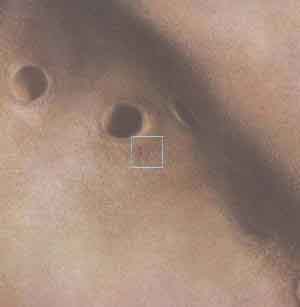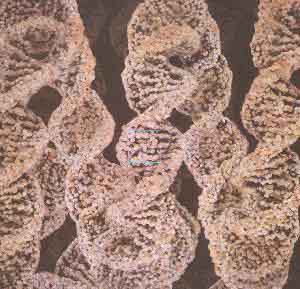(Click on underlined link to go to subject)
Chapter 1. Vision
System Design
Chapter 2. Biological Eye Designs
Chapter
3. Eye
Design
Illustrations
Chapter 4.
Eye
Reproduction
A.
General
requirements
1.
Optical,
computing and intelligence requirements
2.
Design
for eproduction
3.
Physical
development
requirements
B.
Optical
design and
integration
1.
Optical
design issues
2.
Programming
issues relative to probability
3.
Original
intelligence issues
C.
Design
control
1.
Control
of cell complexity
2. The
DNA
plan for control of cell integration
D. Questions and comments on evolution related to eye reproduction
Chapter
5. Optical
Systems
Design
Chapter
6. The Eye Designer
Related
Links
Appendix
A - Slide Show & Conference Speech by Curt Deckert
Appendix
B - Conference Speech by Curt Deckert
Appendix
C - Comments From Our Readers
Appendix
D - Panicked Evolutionists: The Stephen Meyer Controversy
Chapter 4
Section C and D
(Click on PICTURE IN TEXT to bring up LARGE PICTURE)
4. EYE
REPRODUCTION
C.
Design Control
1. Control of cell
complexity
Cell DNA is pre-programmed
with basic design data to reproduce camera- type eyes having a
consistent size, focal length, vision, and interface with the brain.
Control of design in spite of materials variations within each person
indicates a huge design challenge in manufacturing and repair. Eye
design difficulty is increased by the variety of inputs, environments
and purposes.
When we consider eye defects
and diseases, there are amazing repair functions and intelligence
compensations that go on in the eye and brain to give usable vision.
This adds to the case for a designer providing for increased
reliability by building repair functions into the eye.
How many man-made vision systems have this technology?
Ecological systems also show
design. In the design of complex systems, one needs to keep building
blocks as versatile and as small as possible for maximum flexibility.
In eyes, there are a significant variety of controlled building blocks
or cells to make up different tissue types that function in plants,
animals, and humans. Eye cells require very specific variations of
materials for good optical vision. For example, gradient index material
requires a precise array of small material variations with increasing
or decreasing index of refraction in transparent material.
Overall design control seems
to be a necessary part of any discussion on the reproduction of eyes.
It would seem that the illustration of progressive human creativity of
optical systems provides a strong basis for an intelligent design
philosophy, as opposed to the Blind Watchmaker approach set forth by
Dawkins. Optical systems do not fall together without intelligence,
materials, design, fabrication, and assembly.
People are prone to believe in beneficial mutations, but how probable
are they?
There could be little thought
of beneficial mutations, if there weren't bad ones, and it is highly
probable that with respect to eyes most mutations would not be
beneficial. The reproduction process also has to be elegantly designed
to include an orderly progression. Vision is a complex technology, but
the reproduction of specific cells seems to be far more difficult.
Their DNA codes control consistent reproduction of optical design using
specific materials. DNA patterns determine the genetic code information
to provide for specific cell multiplication.
The reproduction process is
full of irreducible complexity. Eye formation is consistent with
specific detailed genetic DNA codes. DNA and RNA designs are so
complex, it is going to take years, using modern computers along with
considerable creativity in software and instrumentation, just to
understand DNA eye code details and the process of reproduction. At the
present time only simple organisms such as bacteria are understood, so
it will take some time just to figure out the copying methodology and
cell mechanics for eyes. Just the fact that so many scientists are
spending so much time and billions of dollars to research DNA design,
communicates the difficulty of understanding the reproduction process.
Assuming we do learn to interpret the eye’s DNA code, we
would also need to know how to communicate, apply power, and control
input to understand gene regulation for reproduction. Human design,
materials and power are necessary in new designs for vision system.
What about all the engineering, manufacturing, and quality control in
our eye?
What if current production engineers waited for natural evolution of
previous products?
2.
The DNA plan for control of cell
integration
|
Our eyes, like life, are
special. They are not just the existence of simple materials that have
arrayed themselves to form a vision system and then reproduce
themselves. Eyes have an overall plan for integration as specified in detail by the genetic code within cells. Specifications and plans for man-made optical systems typically include a series of drawings and specifications that provide a basis for fabrication and integration of one component with another. This is how an engineer would describe detail components and their interrelationships to the full vision system design. Chemical manufacturing is also provided in each cell to provide very specific materials for eye reproduction and repair. The DNA eye plan integrates compact mechanical and complex chemical manufacturing processing designs within each cell. One could equate genetic blueprints to a current production situation, but that is such a crude analogy that it does not fully illustrate the complexity of the reproduction process. To achieve some perspective of the size of a DNA code or pattern within a blood cell, consider the size of a blood cell. It is about 10(-5) of a meter or 10 microns in diameter. Then consider smaller parts within the nucleus of the cell, where DNA coils are on the order of 10(-7) meters in size. The building blocks or features of the DNA code are on the order of 10-(9) meter or a nanometer in size. It takes 400 of these to make up the wavelength of blue light. As a result, it is impossible for an optical microscope to see the detailed features of DNA. Now one can see how it is possible to store massive amounts of DNA information in less area than a computer hard drive or CD ROM uses to store several bits of information (a square of 2 microns x 2 microns x 1 layer thick). See the following illustration to compare the size of the building blocks. (The following 6 figures adapted from pictures in the book Power of Ten - About the Relative Size of Things in the Universe by Philip Morrison & Phylis Morrison and the office of Charles & Ray Eames, Scientific American Library, 1994. These illustrate the relative size of the cells that make up the building blocks of eyes. Also visit "Powers of Ten" web site.) Attention to very small details and communication during the cell reproduction process is truly amazing. There is the huge problem of coordination of many cell interconnections, when integrating programming for high-level image parallel processing in a complex vision system such as eyes. The number of interconnections at the cell level in complex nerve cells may approach 50,000 in cells found in the path from the eyes to the brain. There are millions of connections to eye retina cells that have to remain coordinated to the brain. Thus there is little probability of interfacing man-made eye systems in the same way as nature's eyes. Some new systems that contain thousands of interconnections between microscopic retina contacts may soon provide limited artificial vision over a limited field of view. DNA research may not include answers to fundamental origin questions. If cell origins required power and knowledge outside of physical reality, then all current origin theories could be inadequate. Speculation about historical origins cannot be tested adequately. The study of the origin of materials is complex, as evidenced by design evident in the Periodic Table of elements. This table gives all the natural elements. Some non-stable heavy elements have been temporarily manufactured during recent years. Chemical processing provides for consistency in a wide variety of materials for different eye parts. Specific material variations, complex configurations, and orderly cell arrangements are necessary for image clarity. Even small material or shape deviations can cut down the eye's resolution by a significant amount. One has to understand detailed mathematical models of eye optics to appreciate this. See Figures 4.6 through 4.9 for the effect of a minor variation. The resultant spot size increase indicates ones lack of ability to see fine detail. It is the small size spot on the retina from a very small object approaching infinity that gives us good vision. Since all images are made up of many small spots we must have good transmission of each spot. As the spot size increases there are overlap of spots and a blurred image results. In most lenses we see good center focus while the edge focus degrades significantly. The value of the flexible supporting material around our eyes that allows automatic focusing is evident by our ability to clearly focus on different color objects at a wide variety of distances with widely varying light levels. The eye must work reliably in many different environments without direct engineering, manufacturing, and quality support. The engineering design of nature's eyes is beyond that used to develop current man-made vision systems. |

-- .1mm or 100 microns field of view (10-4 meters) of skin shown for illustration of size 
blood cell - 10 microns field of view (10-5 meters) 
blood cell - 1 microns field of view (10-6 meters) 
cell nucleus - 0.1 micron field (10-7 meters) looking at coiled coils of DNA stored in the 46 chromosomes within each cell 
cell nucleus - 0.01 micron field (10-8 meters)looking at coiled coils of DNA 
cell nucleus -- .001 micron or 1 nanometer field (10-9 meters) looking at the details of DNA structure |
How would we program an eye assembly containing a large number of cells with very critical spatial and materials programming?
The integration of eye light control and information transfer with the brain is made more complex with requirements to make repairs when the eye is damaged. It would seem that intelligent control and sensing using the DNA in each cell would be required. Because of the commonality of organisms reproducing all the time, we seem to miss the overwhelming complex reproductive action going on in eyes.
By now it should be obvious from an engineering point of view that controlled reproduction of a wide variety of different eyes in animals, humans, and plants requires unique plans. Specific actions require the introduction of intelligence. Evidence of programmed intelligence in the actions of animal eyes is apparent as we compare one generation to another generation.
How many of our much less complex engineered optical systems fall together or are reproducible without significant human help?
Therefore, to originate a specific DNA code, one can come to the conclusion that there must be an original designer.
D. Questions and Comments on Evolution
Related to Eye Reproduction
Good science should clarify the problems of evolution as we learn more
about eye reproduction. Some of our present science is due to prior
commitments. It appears that deliberate tunnel vision is designed into
much of today's traditional science.
When people assume natural
selection as an evolutionary explanation, they forget that other,
larger assumptions having to do with the earth's environment, material,
complexity, and the second law of thermodynamics. Beyond this one must
consider the origin of the universe. It requires intelligent power to
reverse the flow of entropy.
Where did initial power come from?
What about the design of the physical elements as indicated by the
periodic table?
Evolutionary speculations
depend on the flow of the state of science at that particular time and
new theories that scientists think can be tested. I certainly wouldn't
trust chance and evolutionary speculations. When taking an engineering
approach to the original evolution of eyes we find a great need for
intelligence. Eye reproduction and the control of design requires us to
ask more difficult questions about origins.
Why are many scientists so dogmatic in claiming that micro-evolution
proves macro-evolution and that an intelligent designer is not
necessary?
Why do these scientists refuse to investigate a designer?
What if today's DNA knowledge were in the hands of scientists of the
1800s?
Would they have come to the same evolutionary conclusions?
Probably not, but there could
have been a more probable scientific conclusion that included a
designer. As scientists gain more experience in vision system design,
it will be easier to appreciate the amazing reproduction of
eyes.
Where did the concept of image processing for vision come
from?
How would one type of creature
communicate with another to learn how eyes function?
Learning to communicate is
expected to be difficult in the most simplistic animals. Even subtle
changes in eyes are not likely to improve vision unless intelligence is
included in the basic design of every building block. Scientists free
to do so should investigate optical design of eyes. Intelligent design
is needed to explain the integration of identical optical designs from
generation to generation, but we really need a higher power to explain
eye reproduction.
Scientists not believing in a
master eye designer leave an awful lot to chance mutations and
therefore require a huge amount of faith. Contrast the millions of
people who design, develop, manufacture, and invent new products to
those products developed by random chance. The probabilities of random
chance eye design are so low that the composite probability illustrates
the impossibility of natural eye occurrences.
Astronomers, physicist, and
chemists are amazed at the fine-tuning of our solar system, Galaxies,
and universe. There are at least 91 requirements for our world to
provide for life as we know it (Dr. Hugh Ross). Natural selection may
not work on non-living, non-producing chemical formations. Often what
looks natural to us is actually supernatural. We will look at
everything differently if we believe that the world was created and is
controlled supernaturally.
Yet, when we consider the
magnitude of intelligence required for developing reproducible eyes;
many people still will not admit, for emotional or other reasons, that
there must be a higher intelligence that provides intelligence for
life.
The number of materials
involved in eyes and the way cells react and grow together also leave
little probability for any answer except for intelligent design. It
seems that Darwin saw some of this, but he declined to explain much
about origins of eyes. Developments related to eye optics details and
the knowledge of image processing was not even existent back when the
theory of evolution was first accepted. Someone had to provide
intelligence for each original cell building block.
One has to ask where DNA reproduction code design came from?
Because of the exacting nature
of imaging on a retina or other such light sensors it is far easier to
believe in an intelligent designer than intelligence evolving randomly.
This is especially true about what happens within a cell without any
outside influence, even though all types of living organisms have
similar systems. When one considers the complexity of cell development
as sub-systems in plants, animals, and humans, the evidence of
evolutionary development is questioned. Each individual eye cell must
be complete to function. This may be why over 90 percent of people say
they believe in God or another higher power. Simply, many evolutionary
experts have been educated without due consideration of intelligent
design of eyes.